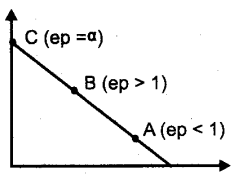Kerala Plus Two Economics Previous Year Question Paper Say 2018 with Answers
| Board | SCERT |
| Class | Plus Two |
| Subject | Economics |
| Category | Plus Two Previous Year Question Papers |
Time: 2½ Hours
Cool off time : 15 Minutes
General Instructions to candidates
- There is a ‘cool off time’ of 15 minutes in addition to the writing time of 2½ hrs.
- Your are not allowed to write your answers nor to discuss anything with others during the ‘cool off time’.
- Use the ‘cool off time’ to get familiar with the questions and to plan your answers.
- Read questions carefully before you answering.
- All questions are compulsory and only internal choice is allowed.
- When you select a question, all the sub-questions must be answered from the same question itself.
- Calculations, figures and graphs should be shown in the answer sheet itself.
- Malayalam version of the questions is also provided.
- Give equations wherever necessary.
- Electronic devices except non programmable calculators are not allowed in the Examination Hall.
Answer all questions from question No.1 to question No. 14 (Total Scores: 26)
Question 1.
The curve showing a set of all possible combinations of two factor inputs that give the same level of output is:
a) Indifference curve
b) Iso-quant
c) Budget Line
d) Rectangular Hyperbola
Answer:
b) Iso-quant
Question 2.
In the following diagrams which one is constant elasticity demand curve?

Answer:
Perfect inelastic demand curve
Question 3.
Identify the type of Economy/Economic System. Basic economic problems regarding allocation of resources are solved through Price Mechanism.
a) Centrally Planned Economy
b) Market Economy
c) Mixed Economy
d) None of the above
Answer:
b) Market Economy
Question 4.
The Great Depression of 1929 affected in the countries of Europe and North America. Which of the following is the outcome of the depression? (1)
a) Increase in GDP Growth rate
b) Increase in employment rate
c) Increase in unemployment rate
d) Increase in per capita income
Answer:
c) Increase in unemployment rate
Question 5.
Give Economic term for the following: (4 × 1 = 4)
a) Pictorial illustration of the interdependence between major sectors of the economy.
b) The total liability of the monetary authority of country.
c) Revenue Expenditure – Revenue Receipts
d) The record of the transactions in goods, services and assets between residents of a country with rest of the world for a specified time period.
Answer:
a) Circular flow of income
b) High powered money
c) Revenue deficit
d) Balance of payment (BoP)
Question 6.
Prepare a demand schedule if the demand function is D(P) = 20 – 2P, if the prices are 2, 4, 6, 8.
Answer:
| Price | Quantity |
| 2 | 16 |
| 4 | 12 |
| 6 | 8 |
| 8 | 4 |
DP = 20 – 2P
When p = 2, 4, 6, 8, etc……
P = 20 – 2 × 2 = 20 – 4 = 16
= 20 -2 × 4 = 20 – 8 =12
= 20 – 2 × 6 = 20 – 12 = 8
= 20 – 2 × 8 = 20 – 16 = 4
Question 7.
In a perfect competitive firm price must be greater than or equal to LRAC in the long-run. As per this condition verify there is any mistake in the following diagram. If so correct the diagram.
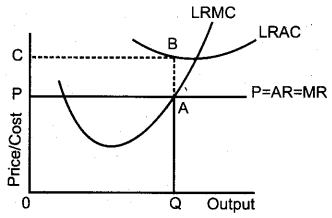
Answer:
Correct diagram showing
P = Minimum LRAC or P > Minimum LRAC
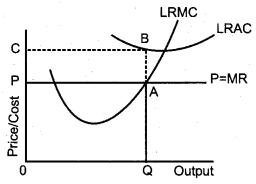
Question 8.
Complete the columns:
| Changes in Demand & Supply | Nature of Changes in Equilibrium Price | Nature of Changes in Equilibrium Quantity |
| Supply remain the same. Demand increases | ||
| Demand and Supply increase in same proportion |
Answer:
| Changes in Demand & Supply | Nature of Changes in Equilibrium Price | Nature of Changes in Equilibrium Quantity |
| Supply remain the same. Demand increases | Equilibrium price increases | Equilibrium Quantity increases |
| Demand and Supply increase in same proportion | equilibrium price constant | Equilibrium Quantity increases |
Question 9.
Classify the following statements into Micro and Macro Economics:
a) RBI announces a new monetary policy.
b) Ramu purchased banana from the market.
c) GDP growth rate declined.
d) Abnormal profit earn by a monopoly firm.
Answer:
Micro Economics:
- Ramu purchased banana from market
- Abnormal profit earn by a monopoly firm
Macro Economics:
- RBI announces a new monetary policy
- GDP growth rate declared
Question 10.
Consider the items given below. Identify the most likely market situation in which they are produced.
a) Oil Producing Industry
b) Indian Railway
Answer:
a) Oligopoly
b) Monopoly
Question 11.
Explain tax revenue and non-tax revenue sources of revenue receipts of the government budget.
Answer:
Tax Revenue:
The most important source of governments revenue is tax revenue.
Taxes are of two types.
- Direct tax
- Indirect tax.
eg. Income tax, Corporate tax
Non Tax Revenue:
It is the recurring income earned by the government from sources other than taxes.
eg. Customs duty, Service tax
Question 12.
The excess of private investment over saving of a country is ₹ 5,000 crores. The amount of Budget deficit is ₹ 500 crores. What was the volume of Trade deficit of that country?
Answer:
Trade deficit = (M – X) = (I – S) + (G – T)
= 5000 + 500
= 5,500
Question 13.
From the following data
a) Derive the consumption function equation
b) Calculate Aggregate consumption
National Income – 1000 crores
Autonomous consumption – 200 crores
Marginal Propensity of consume – 0.70
Answer:
a) Consumption function equation C = \(\overline{\mathrm{C}}\) + c.y
b) Aggregate consumption = 200 + 0.7 × 1000
= 900
Question 14.
The following figures are based on Balance of Payment accounts:
| In ₹ crores | |
| Import of goods | 3, 000 |
| Export of goods | 5, 000 |
| Shipping | 100 |
| Travel and Tourism | 200 |
a) Write Balance of Trade Equation
b) Calculate Balance of Trade.
Answer:
a) Balance of trade equation = Export – Import
b) Balance of trade = 5000 – 3000 = 2,000
Write any 6 questions from question 15 to question 21. Each carry 3 scores. (6 × 3 = 18)
Question 15.
Production | Food | Cloth |
| A | 0 | 50 |
| B | 10 | 45 |
| C | 20 | 35 |
| D | 30 | 20 |
| E | 40 | 0 |
By using the production possibility set draw a production possibility frontier and mark the following points:
a) Fuller Utilisation of Resources
b) Under Utilisation of Resources
Answer:
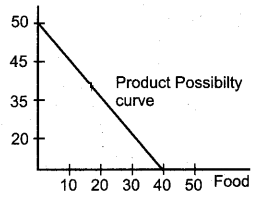
Question 16.
Complete the table.
| Increase in Input % | Increase in Output % | Return to Scale |
| 10% | 20% | |
| 10% | 10% | |
| 10% | 5% |
Answer:
| Increase in Input % | Increase in Output % | Return to Scale |
| 10% | 20% | Increasing returns to sale |
| 10% | 10% | Constant returns to sale |
| 10% | 5% | Decreasing returns to sale |
Question 17.
Observe the following diagram
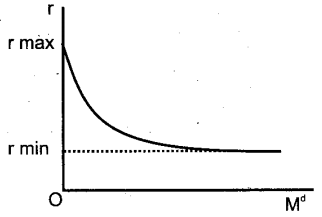
a) Define the liquidity trap and mark it on the diagram.
b) If r = rmax, what will be the speculative demand for money?
Answer:
a) Liquidity Trap: A situation in the economy may arise when everyone will hold their wealth in money balance. If additional money is injected into the economy, it will not be used to purchase bonds. It will be used to satisfy the people’s drawing for money balance without lowering the rate of interest. Such a situation is called ‘liquidity trap’. The liquidity trap is given in the diagram below.
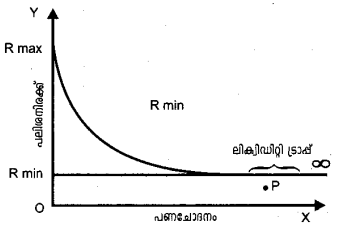
b) O (Mds) = 0
Question 18.
If a shirt costs ₹ 500 in India and $10 in US. The rupee – dollar exchange rate should be ₹ 50 = $1.
Write the effects of the following changes.
(Hint: Increase or decrease)?
| Changes in Exchange Rate and Price | Changes in Export of shirt from India to US |
| Exchange rate changes to ₹ 60 = $1 | |
| Price of shirt in India increased to ₹ 700 | |
| Exchange rate changes to ₹ 40 = $1 |
Answer:
| Changes in Exchange Rate and Price | Changes in Export of shirt from India to US |
| Exchange rate changes to ₹ 60 = $1 | Increases |
| Price of shirt in India increased to ₹ 700 | Decreases |
| Exchange rate changes to ₹ 40 = $1 | Decreases |
Question 19.
Complete the flow chart:

Answer:

Question 20.
The aggregate demand function is AD = 100 + 0.754
a) Calculate the equilibrium income.
b) If Autonomous expenditure increased to ₹ 150 from ₹ 100 calculate the change in equilibrium income.
Answer:
Question is incomplete
Question 21.
a) State the conditions of shutdown point of a firm under perfect competition in the short-run.
b) Represent that shut-down point in a diagram.
Answer:
a) P = Minimum point of AVC
b) The minimum point of AVC is known as shut down point in the short run.

Write any 4 questions (Q. No. 22 to 27). Each carry 5 marks: (4 × 5 = 20)
Question 22.
Short-run cost curves are ‘U’ shaped.
a) Do you agree with this? Give reasons.
b) Draw the SMC and SAC curves on a diagram.
c) Write any two relationship between SAC and SMC.
Answer:
a) Short run cost curves AVC, AC and MC are shaped because of that law of variable proportions.
It operates under the increasing returns due to various internal economics.
b)
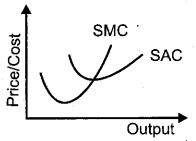
c) When due to the operation of the law of increasing returns, SAC falls, SMC also falls.
If a firm operates under the law of diminishing returns, SAC increases, SMC also increases.
Question 23.
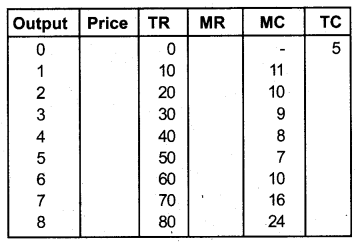
a) Find Price, MR and TC in the above table.
b) From the table, find equilibrium level of output at the profit maximisation conditions of perfect competition in the long-run.
c) Find level of profit at the equilibrium output.
Answer:
a)

b) MC = MR
MC non decreasing
equilibrium output is 6. Here TR = TC
c) Profit = TR – TC
= 60 – 60 = 0
Question 24.
Suppose the equilibrium price of Rubber in the market is ₹ 150/kg.
a) The government intervene in the market and fix a price ₹ 200/kg for Rubber, with a view to protect the rubber cultivators. Name the strategy.
b) What are the effects of that strategy?
c) Draw the diagram to illustrate this.
Answer:
a) Price floor/Support price
b) Excess supply
c) It may lead to lower prices for consumers.
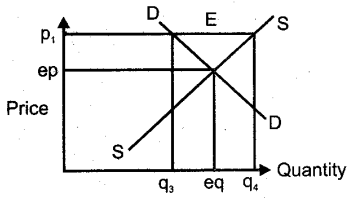
In the diagram ep is market determined price. Since this price is very low this, may lead to loss to producers. So the government will intervene in the market and fix p1 as floor price. This floor price will be higher than market determined price.
Question 25.
Receipts and Expenditure of central government are given below:
Revenue Receipts – 5,250 crores
Revenue Expenditure – 6,200 crores
Borrowing – 1,700 crores
Capital Receipts – 1,800 crores
Capital Expenditure – 850 crores
Calculate by using formula :
a) Gross Fiscal Deficit
b) Revenue Deficit
Answer:
a) Gross fiscal deficit = Net borrowing at home + Borrowing from RBI + Borrowing from abroad.
GFD = 1700
b) Revenue deficit = Revenue expenditure – Revenue receipt
= 6200 – 5250 = 950 crores
Question 26.
Bi-monthly review of RBI reduces the Bank rate from 7% to 6.5%.
a) What are the effects of the policy on money supply and aggregate demand?
b) If cdr = 1 rdr = 0.2 and Higfi powered Money = ₹ 2000 crores. Calculate the total money supply in the economy by using the formula.
Answer:
a) The effect of monetary policy on money supply increases and aggregate demand also increases.

Question 27.
The diagram shows Aggregate equilibrium in the economy:
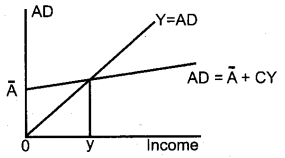
Show diagrammatically the following changes in the Aggregate demand.
a) Autonomous expenditure (\(\overline{\mathrm{A}}\)) increases.
b) Marginal propensity to consume (C) increases
c) Identify the slope parametric shill and intercept parametric shift in the diagrams (a or b)
Answer:
a) Diagram showing parallel upward shift of aggregate demand (AD)
b) In diagram AD swings upwards
c) Points a & b not given in the diagram
Write any 2 questions (28 – 30). Each carry 8 marks: (2 × 8 = 16)
Question 28.
Compare the market conditions of monopoly and perfect competition by considering Number of Sellers, Nature of Product, Freedom of Entry, Demand Curve and Longrun Equilibrium with AC and MC.
Answer:
Perfect Competition:
There are large number of sellers in perfect competition and the commodity is sold at a uniform price. There is no competition and no rivalry among the firms.
Nature of Product:
The output sold under perfect competition will be homogeneous or identical. There will be no difference among the products. Another feature is that the sellers are price takers.
Freedom of Entry:
There is no restriction among firms entering and existing into the market.
Demand Curve:
Under perfect competition whatever be the level of output, price will remain constant. The price line under perfect competition is parallel to x-axis. This shows that under perfect competition, whatever be the level of output, each firm takes the price that is determined in the market. Since the price line is the demand curve, the demand curve is also a straight line parallel to the X-axis.The demand curve is shown below.
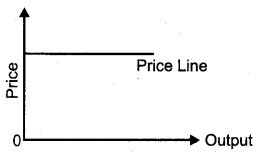
Long run equilibrium with AC and MC:
In the longrun all the costs are variable. When a firm to be in equilibrium the price should be more than or equal to the minimum point of LRAC curve.
Profit maximisation conditions are explain with the help of figure which is given below.
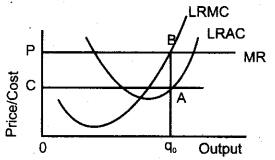
In the diagram 0q0 is the profit maximising level of output. Here all the three conditions of profit maximisation are met
1) P = MR = MC
2) MC curve is non-decrasing
3) Price (p) is more than or equal to minimum point of LRAC.
Monopoly:
Number of sellers: In monopoly market, there is only single seller for a product.
Nature of Product: There is no close substitute in the market. So monopoly firms charge higher price for goods and receive higher profit even in the long run.
Freedom of Entry: There is no freedom of enter into the market. Here firm acts as industry in monopoly market.
Demand Curve: In a monopoly market the firm and the industry are the same. So the firm demand curve and market demand curve would be the same. Demand curve of a monopoly firm will slope negatively which are given below.
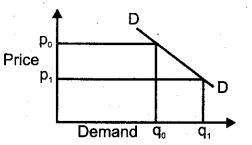
AR curve of a monopoly firm is the same as its demand curve. It slopes downwards from left to right. This means, the monopolist firm can sell less quantity at high price and more quantity at lower price.
Long run equilibrium in monopoly:
Under monopoly finan attains equilibrium when two conditions are fulfilled. They are
i) Marginal revenue and marginal cost should be equal. (MR = MC)
ii) MC curve should cut MR curve from below.
Under monopoly since entry of other firms is prohibited. Firm will get the same level of profit in long run as in the short run.
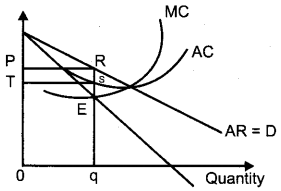
In figure, q is the equilibrium quantity of output that gives maximum profit to the monopoly firm. MR and MC are equal at output q,m MC curve intersects MR curve at point E where MC curve should cut MR curve from below. Under monopoly since price and AR are same, AR at equilibrium quantity is the equilibrium price. Then AR at q is OP. This is the equilibrium price.
Question 29.
Some Macro economic aggregates are given below:
| (In Crores) | |
| Intermediate consumption | 150 |
| Wage | 350 |
| Consumption Expenditure | 400 |
| Changes in Stock | 350 |
| Profit | 200 |
| Import | 150 |
| Export | 250 |
| Rent | 300 |
| Government Expenditure | 200 |
| Interest | 150 |
| Sales | 800 |
| Investment Expenditure | 300 |
a) Identify the three methods to measuring National Income.
b) Calculate GDP from the above data by using any two methods.
Answer:
a) i) Product method
ii) Income method
iii) Expenditure method
b) Product method = P + In + R + W
= 200 + 150 + 300 + 350
= 1,000
Income method = Rent + Wages and salaries + Interest + Gross profits
= 300 + 350 + 150 + 200
= 1,000
Expenditure method = C + I + G + (X – M)
= 400 + 300 + 200 + (250 – 150)
= 1,000
Question 30.
a) Write the five degrees of elasticity and diagrammatically explain it.
b)
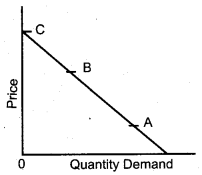
Find elasticity at the points A, B, C.
Answer:
The price elasticity of demand (ed) measures the degree of responsiveness of change in the price on quantity demanded. There are five degrees of elasticity of demand, which are (ep = 0)
i) Perfectly inelastic demand curve (epf = 0)

The demand curve is perpendicular to the x-axis. Even if the price increases or decreases demand will be the same, then demand is perfectly inelastic.
ii) Perfectly elastic demand curve (ep = 0c)

If a very small change in price leads to infinite change in demand. This is known as perfectly elastic demand. The demand curve will be parallel to x-axis.
iii) Unit elastic demand curve (ep = 1)

If a proportionate change in price leads to equal and proportionate change in demand, then demand is unit elastic demand.
iv) Elastic demand curve:
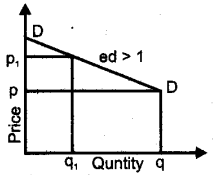
If a proportionate change in price leads to more than proportionate change in demand, it is in the case of elastic demand curve. Here price elasticity of demand is greater than I.
v) Inelastic demand curve
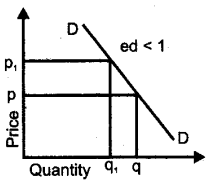
If a proportionate change in price leads to less than proportionate change in demand it is the case of inelastic demand. Here the price elasticity of demand is less than one.
b)
